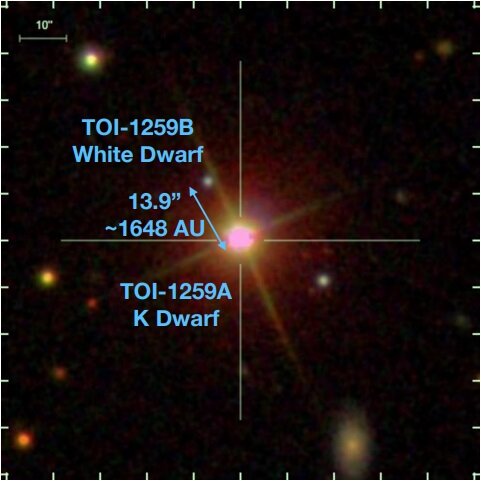TESS is conducting a study of about 200 thousand brightest stars in order to search for exoplanets. At the moment it was
Now a group of astronomers led by David W.Martin of Ohio State University at Columbus reports the detection of a transit signal on the light curve of TOI-1259A, an orange dwarf located about 385 light years from Earth. The planetary nature of this signal has been confirmed by subsequent observations with ground-based telescopes.
The orange dwarf is a main sequence star of spectral type K (in English this type is called a K-dwarf star).
According to a study published in the library arXiv preprints, y parent star TOI-1259A radius leaves0.71 times the radius of the Sun. It is also about 25% less massive than the Sun. The star has a metallicity of about -0.5, its effective temperature is about 4,775 Kelvin (4,502 ° C).
A Jupiter-sized exoplanet labeledTOI-1259Ab is about 56% less massive than the largest planet in the solar system. This planet orbits its star every 3.48 days at a distance of about 0.04 AU. from her. The planet's equilibrium temperature is estimated at about 963 K (689 ° C).
What makes TOI-1259 interesting and strangeplanetary system is the presence of an associated white dwarf companion (TOI-1259B). The object is located at a distance of 1648 AU. from the parent star and has an effective temperature of about 6,300 K (6,026.8 °C). Researchers found that TOI-1259B has a radius of 0.013 times the radius of the Sun and a mass of approximately 0.56 times the mass of our star.
The properties of the white dwarf allowed the team to determine the overall age of the system. According to their estimates, TOI-1259 is about 4.08 billion years old.
Summing up, the researchers noted that the white dwarf is now at a distance that, according to forecasts, will not affect the formation of the planet.
 SDSS image of the host planet TOI-1259A and its associated white dwarf companion TOI-1259B. Credit: Martin et al., 2021
SDSS image of the host planet TOI-1259A and its associated white dwarf companion TOI-1259B. Credit: Martin et al., 2021
Read more
Earth will reach critical temperature in 20 years
Abortion and science: what will happen to the children who will give birth
Named a plant that is not afraid of climate change. It feeds a billion people
Astronomical unit - historicallya unit of measurement for distances in astronomy. Initially, it was assumed to be equal to the semi-major axis of the Earth's orbit, which in astronomy is considered the average distance from the Earth to the Sun
The theoretical temperature that the planet would have if it were an absolutely black body heated only by the star around which the planet revolves.
A parameter characterizing the luminosity (total radiation power) of a celestial body (or other object),